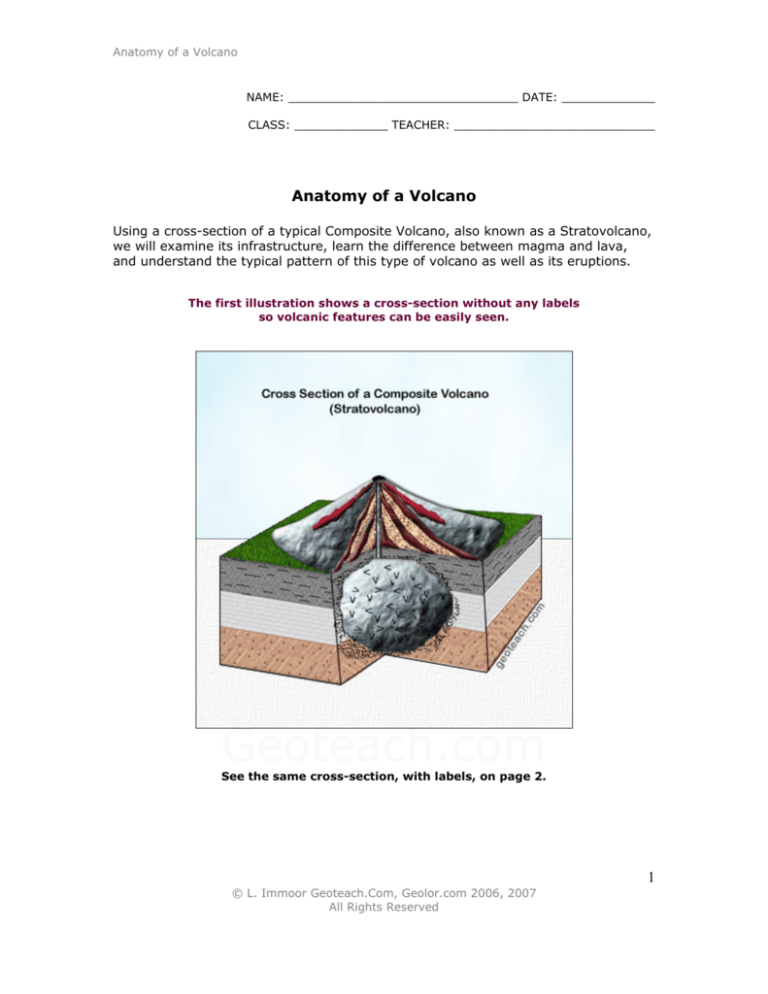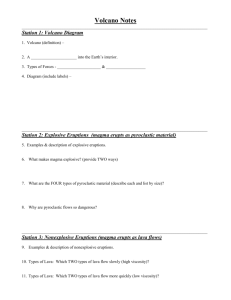
Anatomy of a Volcano
NAME: ________________________________ DATE: _____________
CLASS: _____________ TEACHER: ____________________________
Anatomy of a Volcano
Using a cross-section of a typical Composite Volcano, also known as a Stratovolcano,
we will examine its infrastructure, learn the difference between magma and lava,
and understand the typical pattern of this type of volcano as well as its eruptions.
The first illustration shows a cross-section without any labels
so volcanic features can be easily seen.
Geoteach.com
See the same cross-section, with labels, on page 2.
1
© L. Immoor Geoteach.Com, Geolor.com 2006, 2007
All Rights Reserved
Anatomy of a Volcano
The second illustration shows the same view
but with labels and arrows pointing to significant volcanic features.
Geoteach.com
Description of Volcanic Features:
Volcano - A vent in the surface of the Earth through which magma and
associated gases, pyroclastic and ash erupt. Volcanoes vary in their size
and also in the types of eruptions that take place.
Volcanic Conduit - A volcanic "pipe" of cylindrical-like form through
which magma will exit via the crater on to earth's surface as lava.
Magma Chamber - The cavity underground that contains gas-rich
liquid magma. The magma that moves up from this chamber, through
the volcanic conduit, will erupt as lava on earth's surface.
Lava Flows - Molten (liquid) rock, that originated as magma
underground, and which has reached the surface through a volcanic
eruption, then flows on the earth's surface is referred to a lava. Normally lava
exits through fissures in earth's surface (cracks, vents, craters). It also refers to
cooled and solidified volcanic rock.
2
© L. Immoor Geoteach.Com, Geolor.com 2006, 2007
All Rights Reserved
Anatomy of a Volcano
Solidified Lava Flows - Lava Flows (see above) that have cooled and
hardened into solid rock are "solidified". This igneous material may
easily be seen at earth's surface, it may be buried by other rock material over
time or it may be unseen and part of the internal anatomy of a stratovolcano.
Pyroclastics - Refers to all the fragments (clasts) of rock material that
are formed by a volcanic explosion and ejected from a volcanic vent.
This includes material of all sizes and shapes from large volcanic bombs to
volcanic glass to very small particles of ash (tephra).
Bedrock - Underlying rocks in an area. In the illustrations used above,
3 sedimentary rock layers (sandstone, limestone and shale) were used
as the preexisting bedrock for the area where the volcano formed.
Crater - A steep-sided, usually circular depression formed by either
explosion or collapse at a volcanic vent. On shield volcanoes craters may
form on the sides (flanks) of the volcano. Typically with Cinder Cones and
Stratovolcanoes, the crater is towards the top but that does not preclude the
possibility of a flank eruption as was the case with the Mt. St. Helens eruption in
May, 1980.
Contact Metamorphism - The alteration (change) of preexisting
country rock (bedrock) into a metamorphic rock due to the presence of a
very hot, igneous intrusive body of magma or lava.
Geoteach.com
Magma versus Lava:
Magma is molten (melted), liquid rock emplaced below earth's surface. Lava is molten
rock which has exited a volcanic vent and which flows on earth's surface. The
composition of both is essentially the same. However, once the lava flows, then gases
which were trapped within the buried magma can easily escape so the levels of gases
present lowers.
Both magma and the lava that magma becomes when it erupts vary significantly from
one eruption location to another. Mineral composition, gas content, including water
vapor, varies considerably. Some eruptions produce mafic, basaltic lavas that are low in
gases and silica (quartz), rendering them fluid and less explosive. Partial melting of
mantle rock will produce a more basaltic flow.
Other volcanoes erupt a viscous, felsic, silica-rich lava that traps gases, resists flow and
renders an explosive eruption with devastating effects.
Melting of granitic, crustal rock will produce a more silica-rich, viscous and explosive
flow with accompanying ash falls and debris slides.
The Eruptions:
Shield Volcanoes can reach great heights but their shape is broad and covers a wider
distance. The eruptive material tends to be basaltic lava, which has a low viscosity and
flows easily. The eruptions are more "quiet" and less explosive.
3
© L. Immoor Geoteach.Com, Geolor.com 2006, 2007
All Rights Reserved
Anatomy of a Volcano
Cinder Cones are conical in shape, they do not reach great heights and their slopes are
not overly steep. The eruptive material is pyroclastic in nature with little to no
accompanying lava flows to cement the loose material. The eruptions are explosive and
dangerous as pyroclastics are ejected forcefully from the vent.
Stratovolcanoes (Composite Cones) are explosive in nature and their great heights
and steeply sloped cone shape are achieved by alternating eruptions of thick viscous lava
(resistance to flow) and pyroclastic material. The loose pyroclastics are "cemented" and
held in place by the successive lava flows thereby allowing these volcanoes to maximize
their height and shape. The lava is granitic in composition with abundant silica. The silica
traps gases with resulting extremely dangerous, explosive eruptions.
Lahars (mud flows) and nuée ardente (glowing clouds) can occur during the eruption of
a stratovolcano.
Lahars are a type of mudflow, associated with volcanic eruptions, that occur when
volcanic debris is saturated with water. The material flows down the side of the volcano
causing devastating damage to all in its path. If snow existed on the volcano prior to an
eruption, the heat of the explosion would melt the snow. This would then mix with the
volcanic debris to form the lahar.
A nuée ardente (Fr.) is a super heated, gas-charged cloud of ash, gas, lava, blocks,
and pumice that is expelled with great force from the eruption. Heavy with volcanic
debris, and under the force of gravity, the cloud moves down the side of the volcano at
speeds up to 500 km/hr. It glows due to the excessive incandescent heat of its volcanic
material. Life cannot out run nor escape its suffocating gases and burning heat. All
objects in its path will succumb to its destructive forces.
Magma Type:
Geoteach.com
Shield Volcanoes: Low, broad mountain; gently sloped; up to 9,000 meters high
(approximately 5.6 miles). Mainly basaltic lava with a low silica content; low gas
content; low explosivity. Example: Kilauea, Hawaii.
Cinder Cones: Small mountain with 20°-30° slopes; up to 400 meters high
(approximately 1, 312 feet). Mostly mafic tephra; moderate gas; moderate explosivity.
Example: Paricutín, Mexico.
Stratovolcanoes (Composite Cones): Large mountains; steep slopes; up to 3,000
meters high (approximately 1.86 miles). Intermediate to felsic magmas with a high
silica content; low to high gas content; very high explosivity. Mt. Fuji, in Japan, consists
mainly of basaltic lava; however its composition contains about 50% silicon dioxide
(silica). Example: Mt. St. Helens, Washington.
See page 5 for a graph that shows an approximate height and size comparison
for a Shield Volcano, Cinder Cone and Stratovolcano.
4
© L. Immoor Geoteach.Com, Geolor.com 2006, 2007
All Rights Reserved
Anatomy of a Volcano
For size comparison here is a glimpse (though not drawn to perfect scale)
of how the 3 volcano types would look in silhouette:
Geoteach.com
Visit the Websites about 3 Famous Composite Cone Volcanoes:
Mt. St. Helens in Washington, USA. Erupted May 18, 1980.
Mt. Fuji in Japan. Most recent eruption was in 1707.
Mt. Pinatubo in the Philippines. Erupted June 12, 1991; secondary eruption in May
1994.
Visit these USGS sites to learn more about each volcano type:
Shield Volcanoes
Cinder (Scoria) Cones
Stratovolcanoes
Student Earth Science Worksheet on Volcano Anatomy
There is also an accompanying printable Earth Science assignment based on this lesson
which requires placing labels on a volcano cross-section and answering questions
pertaining to the 3 main volcano types, magma versus lava, magma types and more.
L. Immoor
Earth Sciences, Geology BA, MA
Hofstra University
Hempstead, New York
This lesson and all graphic images are © L. Immoor Geoteach.Com, Geolor.com 2006, 2007
5
© L. Immoor Geoteach.Com, Geolor.com 2006, 2007
All Rights Reserved








